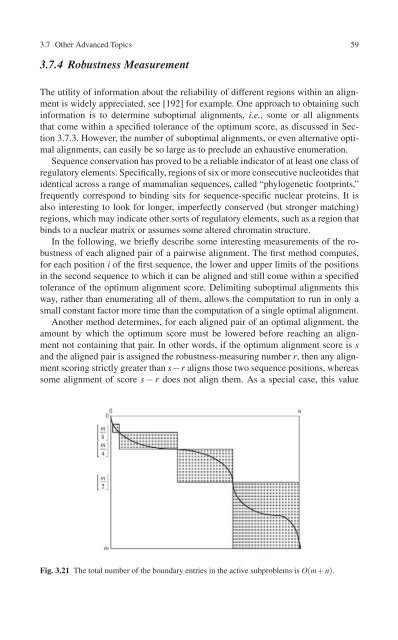Create successful ePaper yourself
Turn your PDF publications into a flip-book with our unique Google optimized e-Paper software.
3.7 Other Advanced Topics 59<br />
3.7.4 Robustness Measurement<br />
The utility of information about the reliability of different regions within an alignment<br />
is widely appreciated, see [192] for example. One approach to obtaining such<br />
information is to determine suboptimal alignments, i.e., some or all alignments<br />
that come within a specified tolerance of the optimum score, as discussed in Section<br />
3.7.3. However, the number of suboptimal alignments, or even alternative optimal<br />
alignments, can easily be so large as to preclude an exhaustive enumeration.<br />
<strong>Sequence</strong> conservation has proved to be a reliable indicator of at least one class of<br />
regulatory elements. Specifically, regions of six or more consecutive nucleotides that<br />
identical across a range of mammalian sequences, called “phylogenetic footprints,”<br />
frequently correspond to binding sits for sequence-specific nuclear proteins. It is<br />
also interesting to look for longer, imperfectly conserved (but stronger matching)<br />
regions, which may indicate other sorts of regulatory elements, such as a region that<br />
binds to a nuclear matrix or assumes some altered chromatin structure.<br />
In the following, we briefly describe some interesting measurements of the robustness<br />
of each aligned pair of a pairwise alignment. The first method computes,<br />
for each position i of the first sequence, the lower and upper limits of the positions<br />
in the second sequence to which it can be aligned and still come within a specified<br />
tolerance of the optimum alignment score. Delimiting suboptimal alignments this<br />
way, rather than enumerating all of them, allows the computation to run in only a<br />
small constant factor more time than the computation of a single optimal alignment.<br />
Another method determines, for each aligned pair of an optimal alignment, the<br />
amount by which the optimum score must be lowered before reaching an alignment<br />
not containing that pair. In other words, if the optimum alignment score is s<br />
and the aligned pair is assigned the robustness-measuring number r, then any alignment<br />
scoring strictly greater than s−r aligns those two sequence positions, whereas<br />
some alignment of score s − r does not align them. As a special case, this value<br />
Fig. 3.21 The total number of the boundary entries in the active subproblems is O(m + n).

















